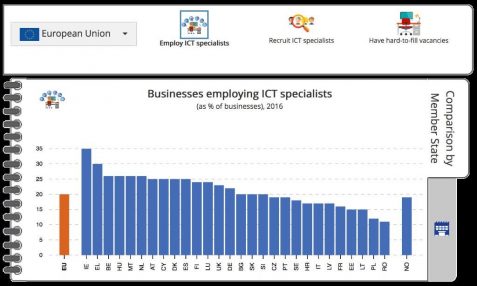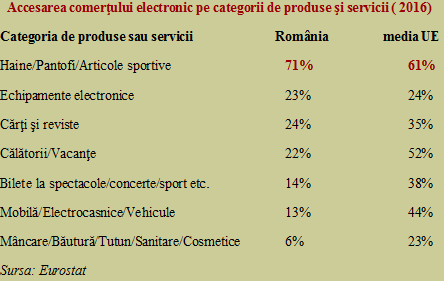 Approximately one fifth of the EU enterprises hired IT specialists in 2016.
Approximately one fifth of the EU enterprises hired IT specialists in 2016.
Unfortunately, contrary to the public perception that we are relatively good at this key chapter of the 21st-century technology, Romania ranks again last among the EU states, slightly above 10% (see chart).
Chart – Share of enterprises hiring an IT specialist in the EU countries, in 2016:
 For reference, we mention that Ireland (35%) and Greece (30%) hold the first two positions in the ranking of the IT specialists hiring, and our Bulgarian neighbours are exactly at the level of the European average. It should also be underlined that at the EU level, the percentage is much higher among large enterprises (75%) than among SMEs (19%).
For reference, we mention that Ireland (35%) and Greece (30%) hold the first two positions in the ranking of the IT specialists hiring, and our Bulgarian neighbours are exactly at the level of the European average. It should also be underlined that at the EU level, the percentage is much higher among large enterprises (75%) than among SMEs (19%).
With only 4%, Romania ranks last in the EU alongside Lithuania in terms of businesses recruiting or trying to recruit an IT specialist, well below the EU average of 9% to which Germany, Austria and Bulgaria are close. Little Malta has 15%, followed by Luxembourg, Spain and the United Kingdom, with 13%.
With 36%, compared to the EU average of 41%, Romania has a middle position among the countries where it is difficult to find the right IT specialist. Therefore, the lack of these specialists is not the main problem, but the lack of businesses’ interest in hiring a person specialized in the IT field.
Between public clichés and reality
Romania is also well below the European average in terms of the proportion of businesses that have a broadband mobile data connection, ranking second to last along with Greece (54%). Bulgaria ranks last (45%), while Finland leads by far by this indicator (94%). On the 2nd and 3rd positions by the same indicator, Croatia (88%) appears on a par with Denmark.
Incidentally, despite the public perception based on the clichés from more developed urban areas, the percentage of Romanians who have accessed the Internet in the last three months is only 70%, below the EU average of 79% and ranking 23rd out of 28 states. Surprisingly, Spain is the country with the highest access rate (93%).
To get an image of our position in terms of e-commerce with the main categories of products and services measured by the European statistics, we present the data on Romania compared to the EU average.
It is noteworthy that in one category out of seven, we are above the EU average and only in the electronic equipment category we are very close to the same average.
*
- E-commerce access rate by product and service categories (2016)
- Product and service category
- Clothes/shoes/sport articles
- Consumer electronics
- Books and magazines
- Travels/holidays
- Tickets to shows/concerts/sport events, etc.
- Furniture/home appliances/vehicles
- Food/drinks/tobacco/sanitary items/cosmetics
- Source: Eurostat
*
The relatively weak position in most categories should not surprise us if we consider the fact that we rank the last by the share of businesses doing electronic sales with 7% compared to the European average of 20%. As a reference, we could take the Czech Republic (27%), positioned in the European ranking between Sweden (28%) and Belgium (26%).
By contrast, a field where we have a fairly good position is the IT security policy that places us (with 28% of businesses compared to an EU average of 32%) along with Austria on the 20th position out of 28, far away from the laggards Hungary (10%) and Poland (13%).
All in all, we should draw the conclusions that are required based on the Eurostat’s analysis and use a much larger proportion of the IT specialists we train and from whom others benefit if we do not really care about using them. As well as stimulate the development of modern forms of e-commerce, if we want an increased business efficiency and an improved productivity to support the sustainable growth of businesses.










